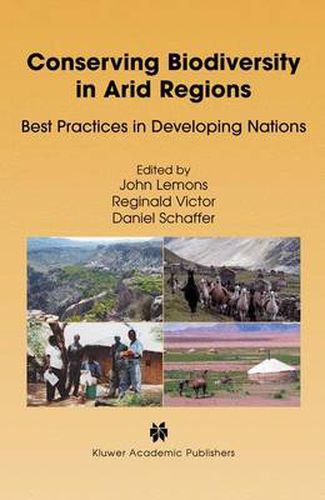Readings Newsletter
Become a Readings Member to make your shopping experience even easier.
Sign in or sign up for free!
You’re not far away from qualifying for FREE standard shipping within Australia
You’ve qualified for FREE standard shipping within Australia
The cart is loading…






This title is printed to order. This book may have been self-published. If so, we cannot guarantee the quality of the content. In the main most books will have gone through the editing process however some may not. We therefore suggest that you be aware of this before ordering this book. If in doubt check either the author or publisher’s details as we are unable to accept any returns unless they are faulty. Please contact us if you have any questions.
The protection of biodiversity and sustainable use of resources in arid and semiarid regions is important because: more than one-third of the earth’s land area is drylands; up to one billion people (mostly poor) depend on drylands for their survival; the biological resources of drylands are both unique and vulnerable; and loss of dryland species increases the threats to the lives of millions of people. In Southern (developing) nations, successful experiences in conserving biodiversity and utilizing sustainable resources have not been publicized widely and hence have not been replicated in other relevant circumstances. For example, much of the available information on a wide variety of best practices and lessons learned for protecting and sustainably using arid and semiarid zone biodiversity remains within the institutions in which it has been generated and has not been shared between others working on similar issues for the mutual benefit of the global environment. Lack of financial resources constrains developing nations and their scientific institutions to widely disseminate the results of studies and projects as well as their ability to increase partnerships, cooperation, and capacity building between institutions and various stakeholders. The overall goal of this book is to increase the size of and more widely disseminate the portfolio of research and other works aimed at protecting and sustainably utilizing biodiversity of global significance in arid and semiarid areas in developing nations. Specifically, the book focuses on best practices and lessons learnt for science, for public policy and management, for increasing the participation of local people in decision making, and for enhancing partnerships and capacity building between institutions. In part, the successful practices and programmes described in this book are a follow up to the Earth Summit Conference and the ratification of the Convention on Biological Diversity (CBD) and the Convention to Combat Desertification (CCD) and, hence, provide examples of understudied measures by Southern nations to conserve and sustainably use biodiversity.
$9.00 standard shipping within Australia
FREE standard shipping within Australia for orders over $100.00
Express & International shipping calculated at checkout
This title is printed to order. This book may have been self-published. If so, we cannot guarantee the quality of the content. In the main most books will have gone through the editing process however some may not. We therefore suggest that you be aware of this before ordering this book. If in doubt check either the author or publisher’s details as we are unable to accept any returns unless they are faulty. Please contact us if you have any questions.
The protection of biodiversity and sustainable use of resources in arid and semiarid regions is important because: more than one-third of the earth’s land area is drylands; up to one billion people (mostly poor) depend on drylands for their survival; the biological resources of drylands are both unique and vulnerable; and loss of dryland species increases the threats to the lives of millions of people. In Southern (developing) nations, successful experiences in conserving biodiversity and utilizing sustainable resources have not been publicized widely and hence have not been replicated in other relevant circumstances. For example, much of the available information on a wide variety of best practices and lessons learned for protecting and sustainably using arid and semiarid zone biodiversity remains within the institutions in which it has been generated and has not been shared between others working on similar issues for the mutual benefit of the global environment. Lack of financial resources constrains developing nations and their scientific institutions to widely disseminate the results of studies and projects as well as their ability to increase partnerships, cooperation, and capacity building between institutions and various stakeholders. The overall goal of this book is to increase the size of and more widely disseminate the portfolio of research and other works aimed at protecting and sustainably utilizing biodiversity of global significance in arid and semiarid areas in developing nations. Specifically, the book focuses on best practices and lessons learnt for science, for public policy and management, for increasing the participation of local people in decision making, and for enhancing partnerships and capacity building between institutions. In part, the successful practices and programmes described in this book are a follow up to the Earth Summit Conference and the ratification of the Convention on Biological Diversity (CBD) and the Convention to Combat Desertification (CCD) and, hence, provide examples of understudied measures by Southern nations to conserve and sustainably use biodiversity.